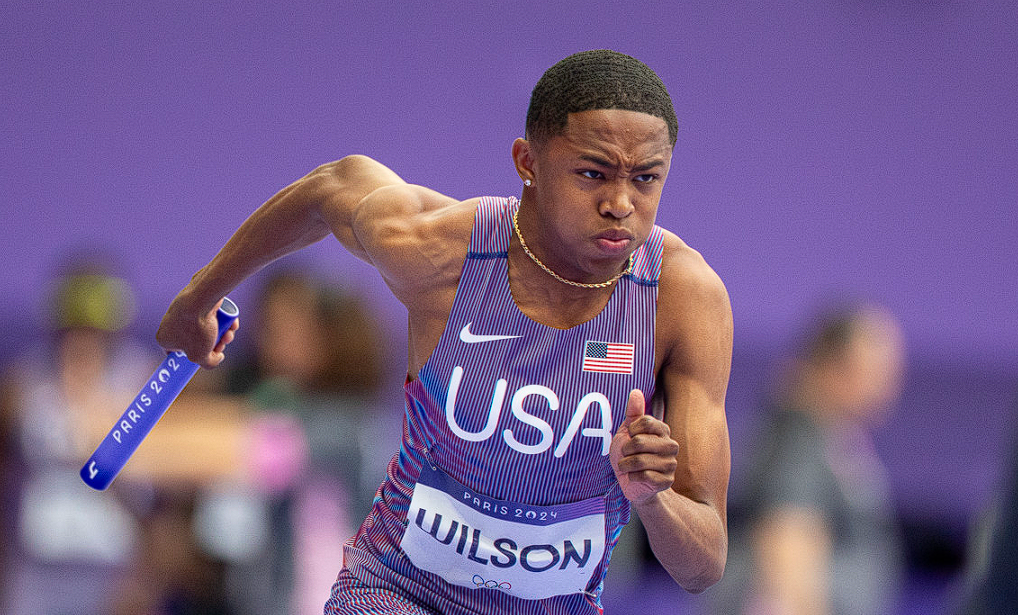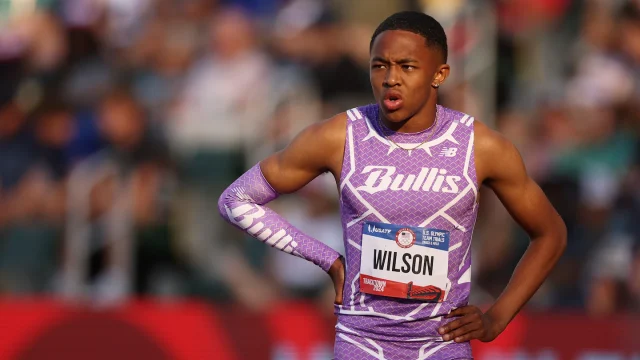Six months have passed since Wilson became the youngest man track and field champion in history when he won relay gold in the Olympics in Paris at the age of 16. With his foot firmly on the gas as he resumes indoor racing, that already seems like a faraway memory.
Despite his almost constant boyish smile, it is easy to forget that Wilson is still a high school student. He will continue to pursue his athletic goals in addition to lessons and assignments at Maryland’s Bullis School until next year, when he will graduate.
That entails rising at five in the morning. every day and boarding the bus at approximately 6:15 in order to reach school at 7:30. “Do I enjoy getting up early? Wilson responds, “No, but I have to do what I have to do.”
After a long day of school, he practices at the track from 3 to 6 p.m. After that, he must return home to finish up his coursework and be ready for any tests he may have the following day. This is hardly a normal routine for someone who finished as one of the world’s fastest 400-meter runners the previous year.
However, Wilson emphasizes that his top priority is his schoolwork.
He has not decided on his top institution yet, but when the time comes, he wants to go one with “excellent athletics, great academics, wonderful teammates, amazing support – just great staff all around.”
Wilson is currently focused on the indoor season and spends his weekends traveling to East Coast tournaments. He will compete in the 600-meter event at the Millrose Games in New York City on Saturday after breaking his own indoor high school 400-meter record in Boston last weekend with a time of 45.66 seconds over two track laps.

Wilson, who has already set one record this year, could aim to beat Will Sumner’s high school 600-meter record of 1:15.58 at the Millrose Games, although doing so would require cutting his time from the previous year by nearly two seconds.
Wilson’s performances this season will surely be scrutinized more intensely due to his youthfulness, extraordinary potential, and recent Olympic gold medal.
At the US Olympic Trials last year, he became well-known after breaking the under-18 400-meter world record twice and placing sixth in the final. Wilson became the youngest American to compete in track and field at the Olympics after earning a position in the relay pool, even though it was not enough for an individual spot on the squad.
He finished ninth at the end of the first leg of the 4x400m relay heats in Paris, weeks after setting another under-18 record of 44.2 seconds. He was far from at his peak. However, with hurdles specialist Rai Benjamin joining the squad, the US squad—which included Wilson, Vernon Norwood, Bryce Deadmon, and Christopher Bailey—securing a position in the final and winning gold.
Wilson subsequently disclosed that he had suffered a hamstring injury shortly after being selected for the Olympic team, yet it was still enough to win him a gold for running in the heat. He calls the Olympic experience a “dream come true” and “the finest thing that could possibly happen to me,” even though he ran far slower than he did at the trials.

Wilson’s summer was filled with engagements and invitations, which are still coming in at a rapid pace today. He traveled to baseball and football events throughout Baltimore, saw Jay-Z, and visited colleges. Being a big Ravens fan, he spent time at the team’s facility, had his picture taken with quarterback Lamar Jackson, and received cleats from wide receiver Zay Flowers.
Wilson may have considered a career in the NFL in a previous life. Only at the age of fifteen did he decide to devote himself entirely to track after being the top scorer on his high school team during his freshman year.
Incredibly, Wilson was just four years old in 2012 when the Ravens made their final Super Bowl trip. Since then, he has developed into one of the most talented young athletes of his generation, already competing against and defeating much more seasoned rivals.
His quick ascent to senior racing has not deterred him in that period. Even though the competition is more intense and the stakes are larger, the fundamental goal of running a single lap as quickly as possible remains the same.
However, Wilson’s strategy also involves being unorthodox, which is essential to the contrast between his life as a high school student and an elite runner. He is half schoolboy, figuring out when to acquire his driver’s license and when to finish his schoolwork, and half Olympian and gold medalist.
Wilson has put things like his license on wait for the time being. But for much of the last 12 months, he has tried to remind himself that “you are a kid and a 16-year-old who is going to school and having fun and doing a lot of nice things that a teenager’s doing.”
Few Olympic gold medalists in track and field and other sports have been able to say that.








